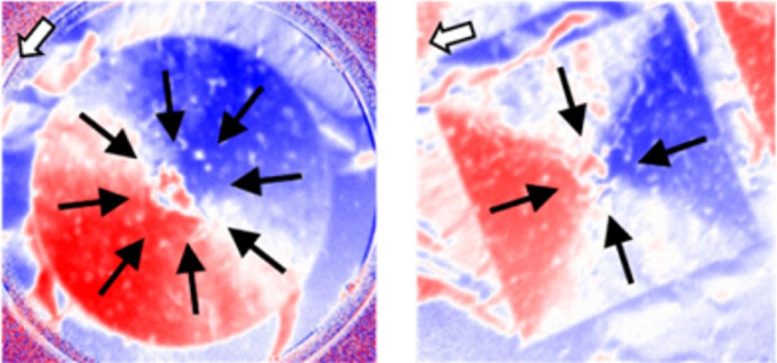Researchers have developed a method to use superconducting structures and surface defects to create and stabilize complex spin textures such as radial vortices. This advance could significantly impact spintronics by allowing the use of a variety of ferromagnetic materials and enhancing data storage and logic operations with lower power consumption. Image source: SciTechDaily.com
A team at HZB has investigated a new, simple method for generating stable radial magnetic eddy currents in magnetic films on BESSY II.
In some materials, spins form complex magnetic structures at the nanometer and micrometer scales, where the magnetization twists and curls along specific directions. Examples of such structures are magnetic bubbles, skyrmions, and magnetic vortices.
The goal of spintronics is to use such tiny magnetic structures to store data or perform logic operations with very low power consumption compared to today’s dominant microelectronic components. However, the generation and stability of most magnetic textures is limited to a few materials and can be achieved under very specific conditions (temperature, magnetic field…).
a new approach
An international collaboration led by HZB physicist Dr. Sergio Valencia has now investigated a new method for creating and stabilizing complex spin textures, such as radial vortices, in a variety of compounds. In radial eddy currents, the magnetization is directed toward or away from the center of the structure. This type of magnetic configuration is usually very unstable. In this novel approach, radial vortices are generated with the help of superconducting structures, and their stability is achieved through the presence of surface defects.

The team led by Sergio Valencia analyzed the samples using XMCD transmission photoelectron microscopy of BESSY II. The images show radially aligned spin textures in round and square samples composed of ferromagnetic material on superconducting YBCO islands. The white arrow shows the incident X-ray beam. Image source: ©HZB
Superconducting YBCO-Islands
The sample consists of micron-sized islands made of the high-temperature superconductor YBCO with ferromagnetic compounds deposited on them. After cooling the sample below 92 Kelvin (-181 °C), YBCO enters a superconducting state. In this state, an external magnetic field is applied and immediately removed. This process allows the penetration and pinning of magnetic flux quanta, which in turn generates stray magnetic fields. It is this stray field that creates new magnetic microstructures in the ferromagnetic layer above: spins are emitted radially from the center of the structure, like radial vortices.
The role of defects
As the temperature increases, YBCO transitions from a superconducting state to a normal state. Therefore, the stray field generated by the YBCO island disappears and the magnetic radial eddy currents should also disappear. However, HZB researchers and collaborators observed that the presence of surface defects prevented this from happening: the radial vortices partially preserved the imprinted state even at temperatures close to room temperature.
“We used the magnetic field generated by the superconducting structure to imprint certain magnetic domains on a ferromagnet placed on top of it, and used surface defects to stabilize them. This magnetic structure is similar to skyrmions and is very useful for spintronics applications. interesting.
Geometry is important
The smaller imprinted vortices are about 2 microns in diameter, about ten times the size of a typical skyrmion. The research team studied samples with circular and square geometries and found that circular geometry increased the stability of imprinted magnetic radial eddy currents.
“This is a novel method of creating and stabilizing such structures that can be applied to a variety of ferromagnetic materials. These bring excellent new prospects for the further development of superconducting spintronics.”
Reference: “Size dependence and high-temperature stability of radial vortex magnetic textures imprinted by superconducting stray fields” Authors: David Sanchez-Manzano, Gloria Orfila, Anke Sander, Lourdes Marcano, Fernando Gallego, Mohamad-Assaad Mawass, Francesco Grilli, Ashima Arora, Andrea Peralta, Fabian A. Cuellar, Jose A. Fernandez-Roldan, Nicolas Reyren, Florian Kronast, Carlos Leon, Alberto Rivera-Calzada, Javier E. Villegas, Jacobo Santamaria and Sergio Valencia, April 2024 Year and day, ACS Applied Materials & Interfaces.
DOI: 10.1021/acsami.3c17671
#Spintronics #breakthrough #Unleashing #power #radial #vortices
Image Source : scitechdaily.com
